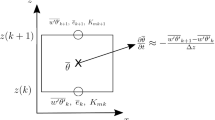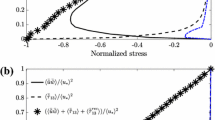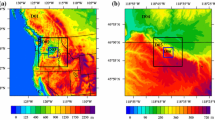Abstract
The impact of two boundary-layer parameterisation schemes on the prediction of Indian monsoon systems by a global spectral model has been investigated. The turbulent kinetic energy closure scheme shows a positive impact on the prediction of some important synoptic features, including the genesis of monsoon lows, the tracking of monsoon depressions, and precipitation.
Similar content being viewed by others
References
Anthes, R A.: 1977, ‘A Cumulus Parameterisation Scheme Utilising a One Dimensional Cloud Model’, Mon. Wea. Rev. 105, 270-286.
Arakawa, A.: 1972, ‘Design of the UCLA General Circulation Model’, Tech. Rep. No. 7, Department of Meteorology, University of California, Los Angeles, 116 pp.
Asnani, G. C.: 1993, Tropical Meteorology, Vols. I and II, G. C. Asnani, Pune, India, 603 pp. and 598 pp.
Basu, S. and Raghavan, N.: 1986, ‘Prediction of Inversion Strengths and Heights from a 1D Nocturnal Boundary Layer Model’, Boundary-Layer Meteorol. 35, 193-204.
Beljaars, A. C. M., Walmsley, J. L., and Taylor, P. A.: 1987: ‘A Mixed Spectral Finite Difference Model for Neutrally Stratified Boundary Layer Flow over Roughness Changes and Topography’, Boundary-Layer Meteorol. 38, 273-303.
Blackadar, A. K.: 1962, ‘The Vertical Distribution of Wind and Turbulence in a Neutral Atmosphere’, J. Geophys. Res. 67, 3095-3102.
Deardorff, J. W.: 1966, ‘The Contragradient Heat Flux in the Lower Atmosphere and in the Laboratory’, J. Atmos. Sci. 23, 503-506.
Deardorff, J. W.: 1972, ‘Parameterization of the Planetary Boundary Layer for Use in General Circulation Models’, Mon. Wea. Rev. 100, 93-106.
Detering, H. W. and Etling, D.: 1985, ‘Application of the E-∈ Turbulence Closure Model to the Atmospheric Boundary Layer’. Boundary-Layer Meteorol. 33, 113-133.
Fels, S. B. and Schwarzkopf, M. D.: 1981, ‘An Efficient Accurate Algorithm for Calculating CO2 15 µm band cooling rates’, J. Geophys. Res. 86, 1205-1232.
Holt, T. and Raman, S.: 1988, ‘A Review and Comparative Evaluation of Multi-Level Boundary Layer Parameterisations for First Order and Turbulent Kinetic Energy Closure Schemes’, Reviews of Geophys. 26, 761-780.
Holtslag, A. A. M. and Boville, B. A.: 1993: ‘Local Versus Nonlocal Boundary Layer Diffusion in a Global Climate Model’, J. Climate 6, 1825-1842.
Holtslag, A. A. M. and Moeng, C.-H.: 1991, ‘Eddy Diffusivity and Countergradient Transport in the Convective Atmospheric Boundary Layer’, J. Atmos. Sci. 48, 1690-1698.
Kanamitsu, M.: 1989, ‘Description of the NMC Global Data Assimilation and Forecast System’. Weather and Forecasting 4, 335-342.
Kessler, E.: 1969, ‘On the Distribution and Continuity of Water Substance in Atmospheric Circulations’, Met. Monographs 10(32), Amer. Met. Soc., Boston, 84 pp.
Kitada, T.: 1987, ‘Turbulence Transport of a Sea Breeze Front and its Implication in Air Pollution Transport - Application of k-∈ Turbulence Model’, Boundary-Layer Meteorol. 41, 217-239.
Lacis, A. A. and Hansen, J. E.: 1974, ‘A Parameterisation for the Absorption of Solar Radiation in the Earth's Atmosphere’, J. Atmos. Sci. 31, 118-133.
Leith, C. E.: 1971, ‘Atmospheric Predictability and Two Dimensional Turbulence’, J. Atmos. Sci. 28, 145-161.
Lindzen, R. S.: 1981, ‘Turbulence and Stress due to Gravity Wave and Tidal Breakdown’, J. Geophys.Res. 86, 9707-9714.
Lumley, J. L.: 1980, ‘Second Order Modelling of Turbulent Flows, in Prediction Methods for Turbulent Flows’, in W. Kollmann (ed.), Hemisphere, London, pp. 1-31.
Mahrt, L.: 1976, ‘Mixed Layer Moisture Structure’, Mon. Wea. Rev. 104, 1403-1407.
Manabe, S., Smagorinsky, J., and Strickler, R. F.: 1965, ‘Simulated Climatology of a General Circulation Model with a Hydrologic Cycle’, Mon. Wea. Rev. 93, 769-798.
Marchuk, G. I., Kochergin, V. P., Klinok, V. I., and Sukhorukor, V A.: 1977, ‘On the Dynamics of the Ocean Mixed Layer’, J. Phys. Oceanog. 7, 865-875.
Mitra, A. K., Bohra, A. K., and Rajan, D.: 1997, ‘Daily Rainfall Analysis for Indian Summer Monsoon Region’, Int. J. Climatol. 17,1083-1092.
Orszag, S. A.: 1970, ‘Transform Method for Calculation of Vector-Coupled Sums: Application to the Spectral Form of the Vorticity Equation’, J. Atmos. Sci. 27, 890-895.
Pan, H.-L.: 1990, ‘A Simple Parameterisation Scheme of Evapotranspiration over Land for NMC Medium Range Forecast Model’, Mon. Wea. Rev. 118, 2500-2512.
Pant, M. C.: 1993: Some Characteristic Features of Low Level Southwest Monsoon Flow over the Arabian Sea, Ph.D Thesis, Berhampur University, Orissa, India, 239 pp.
Parrish, D. F. and Derber, J. C.: 1992, ‘The NMC's Spectral Statistical Interpolation Analysis System’, Mon. Wea. Rev. 120, 1747-1763.
Pierrehumbert, R. T.: 1986, ‘An Essay on the Parameterisation of Orographic Gravity Wave Drag’, Seminar/Workshop 1986, Observation, Theory and Modelling of Orographic Effects, ECMWF, Reading, U.K., pp. 251-282.
Raghavan, N. and Basu, S.: 1988, ‘Prediction of Wind Speed Direction and Diffusivity under Neutral Conditions for Tall Stacks’, J. Appl. Meteorol. 24A, 801-810.
Rao, Y. P.: 1976, ‘Southwest Monsoon’, Meteorological Monograph Synoptic Meteorology, No. 1/1976, India Meteorological Department, Pune, India, 367 pp.
Robert, A., Henderson, J., and Turnbull, C.: 1972, ‘An Implicit Time Integration Scheme for Baroclinic Models of the Atmosphere’, Mon. Wea. Rev. 100, 329-335.
Robert, A.: 1981, ‘A Stable Numerical Integration Scheme for Primitive Meteorological Equation’, Atmos. Oceanog. 19, 35-46.
Slingo, J. M.: 1987, ‘The Development and Verification of a Cloud Prediction Scheme for the ECMWF model’, Quart. J. Roy. Meteorol. Soc. 115, 899-926.
Stull, R. B.: 1988, An Introduction to Boundary Layer Meteorology, Kluwer Academic Publishers, Dordrecht, 666 pp.
Stull, R. B.: 1991, ‘Static Stability: An Update’, Bull. Amer. Meteorol. Soc. 72, 1521-1529.
Tiedtke, M.: 1983, ‘The Sensitivity of the Time Mean Large Scale Flow to Cumulus Convection in the ECMWF Model’, in Workshop on Convection in Large Scale Numerical Models, ECMWF, pp. 297-316.
Author information
Authors and Affiliations
Rights and permissions
About this article
Cite this article
Basu, S., Begum, Z.N. & Rajagopal, E.N. Impact of Boundary-Layer Parameterisation Schemes on the Prediction of the Asian Summer Monsoon. Boundary-Layer Meteorology 86, 469–485 (1998). https://doi.org/10.1023/A:1000708209147
Issue Date:
DOI: https://doi.org/10.1023/A:1000708209147




